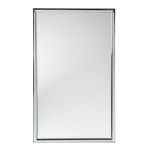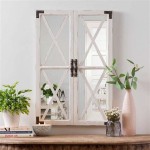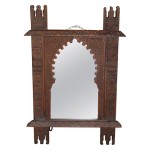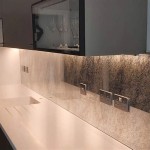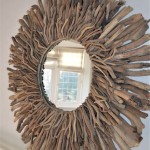How To Hang a Heavy Mirror Without Hooks
Hanging a heavy mirror without traditional hooks presents unique challenges but is entirely achievable with the right tools and techniques. This approach often relies on adhesive systems or specialized hardware designed to distribute weight evenly and securely fasten the mirror to the wall without visible hanging mechanisms.
Prior to attempting to hang a heavy mirror, it's crucial to assess the mirror's weight and dimensions accurately. Manufacturers often provide weight information. If unavailable, a bathroom scale can be used. Measuring the mirror's dimensions is also essential for determining appropriate placement and selecting the correct mounting hardware.
Wall type significantly influences the choice of hanging method. Drywall necessitates different hardware compared to plaster, concrete, or brick. Determining the wall composition is a fundamental first step. A simple test, like tapping the wall and listening for a hollow sound, can often differentiate drywall from more solid materials. For a more definitive assessment, a small test hole can be drilled in an inconspicuous area.
Several adhesive systems designed for heavy objects can be used for hanging mirrors. These specialized adhesives are formulated to bond strongly with various surfaces and distribute weight effectively. It's essential to select an adhesive explicitly rated for the mirror's weight and the specific wall material. Manufacturers' instructions should be followed precisely for optimal adhesion and safety.
When using adhesive, thorough surface preparation is key to a strong bond. Both the back of the mirror and the wall surface should be cleaned thoroughly to remove dust, grease, and other debris that could compromise adhesion. Isopropyl alcohol is an effective cleaning agent for most surfaces. Ensuring a dry and clean surface is critical for optimal adhesive performance.
Applying the adhesive according to the manufacturer's guidelines is paramount. This may involve applying adhesive in a specific pattern or using a caulking gun for even distribution. Some adhesives require a setting time before the mirror can be mounted. Adhering to the prescribed instructions ensures the strongest possible bond and minimizes the risk of the mirror shifting or falling.
While adhesives offer a hook-free solution, certain circumstances may necessitate mechanical fasteners, especially for exceptionally heavy mirrors or uneven walls. French cleats, z-clips, and mirror mounting clips are examples of specialized hardware that can provide a secure and discreet hanging solution. These systems typically rely on two interlocking components, one attached to the wall and the other to the back of the mirror, providing a strong and stable connection.
French cleats consist of two mating pieces of wood, one with a beveled edge attached to the wall and the other with a corresponding beveled edge attached to the mirror. The beveled edges interlock, creating a secure and flush mount. This system distributes the weight evenly across the cleat, making it suitable for heavier mirrors.
Z-clips function similarly to French cleats but are typically made of metal and offer a lower profile. They consist of two interlocking pieces, one mounted to the wall and the other to the mirror. This method is particularly useful for mirrors that require a close fit against the wall.
Mirror mounting clips are designed specifically for holding mirrors and often feature adjustable screws for precise alignment. These clips typically attach to the bottom and sides of the mirror and provide support while allowing the mirror to rest flush against the wall. They are suitable for lighter to medium-weight mirrors.
Regardless of the chosen method, ensuring proper weight distribution is crucial for stability and safety. For larger or heavier mirrors, employing multiple mounting points or a combination of adhesive and mechanical fasteners may be necessary. Distributing the weight evenly prevents excessive stress on any single point and reduces the risk of the mirror detaching.
Safety precautions are paramount when hanging heavy objects. Wearing appropriate safety gear, such as gloves and eye protection, is recommended when working with adhesives or power tools. Seeking assistance when lifting and maneuvering a heavy mirror is advisable to prevent injury and ensure proper placement. Using a level to ensure the mirror hangs straight is also essential for aesthetic appeal and stability.
Once the mirror is mounted, periodically inspecting the hanging system is essential. Checking for signs of adhesive weakening, loose screws, or any shifting of the mirror can help prevent potential problems. Addressing any issues promptly maintains the mirror's secure attachment and ensures long-term stability.
How To Hang A 100 Pound Mirror On Drywall Quora
:strip_icc()/ScreenShot2022-04-28at1.12.19PM-e055476c70c6438585fa7c5cd531edcf.png?strip=all)
4 Easy Ways To Hang A Heavy Mirror

How To Hang A Large Or Heavy Mirror

Picture Wire Strung Between Two D Rings Attached To The Back Of A Frame Hanging Mirror Heavy Installation

How To Hang A Frameless Mirror On The Wall With Pictures

How To Hang Heavy Mirrors Frames Without Nails 3m

Tip How To Hang Something Heavy With Minimal Wall Damage Home Stories A Z Life S Hanging Mirror Simple
How To Hang A Mirror With No Hooks Quora

How To Hang A Heavy Mirror Or Picture True Value

How To Install A Mirror Without Frame Merrypad


